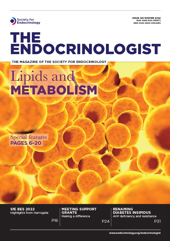Clinical, mechanistic and societal awareness of polycystic ovary syndrome (PCOS) is steadily improving. However, our quest for novel therapeutic options needs to accelerate.
Debate in relation to the diagnostic criteria for PCOS has raged for over three decades. Most international consensus groups agree that the cardinal clinical features are oligomenorrhoea coupled with clinical or biochemical evidence of androgen excess. Awareness of the long term metabolic health complications of PCOS has increased significantly in recent years.
PCOS-related health costs in the USA were estimated at a staggering $8 billion in 2020,1 with between 7% and 17% of all women affected, depending on the diagnostic criteria applied. However, PCOS consistently receives relatively paltry National Institute for Health and Care Research funding, which is dwarfed by that allocated to many other chronic diseases.2 It is also very telling that the first international clinical practice guideline for PCOS was only published in 2018.3
PATHOPHYSIOLOGY AND HEALTH CONSEQUENCES
Androgen excess is one of the central pathophysiological features of PCOS. Its pathogenesis reflects a complex interplay between insulin resistance and androgen metabolism, with hyperinsulinaemia driving androgen generation at the level of the ovary, adrenal and adipose tissue.4 Whilst not included in diagnostic criteria, up to 75% of women with PCOS demonstrate features of insulin resistance.5 Androgen excess and insulin resistance together underpin the metabolic perturbations observed in PCOS.
'The sheer scale of prevalence of PCOS in the background population, means that there is a hidden health epidemic grumbling below the radar of mainstream health surveillance.'
Women with PCOS have a two- to fourfold increased risk of developing type 2 diabetes mellitus over the course of their lifespan, compared with the matched background population.6 Higher incidence rates of ischaemic heart disease, obstructive sleep apnoea and non-alcoholic fatty liver disease have been reported in multiple studies. A retrospective cohort study of 176,000 women with PCOS in the Clinical Practice Research Datalink dataset demonstrated a 26% increase in non-fatal myocardial infarction, revascularisation and angina.7
Long term health consequences of PCOS are not limited to metabolic dysfunction and subfertility. Higher rates of mental health disorders and reduced quality of life are regularly reported by women with PCOS. Adverse neurodevelopmental outcomes appear to be increased in children born to women with PCOS, including higher rates of autism spectrum disorder and attention deficit hyperactivity disorder.8 A recent study from the North Finland Birth Cohort found that women with PCOS had a lower potential to remain in permanent employment by the age of 46, gaining on average 30 additional disability and unemployment days compared with controls over the course of their working careers.9
A HIDDEN HEALTH EPIDEMIC
Clearly many patients with PCOS have a mild clinical phenotype and do not require any specific health interventions. The cohort of patients who attend our endocrinology and gynaecology clinics are likely to represent the more severe end of the phenotypic spectrum. However, the sheer scale of prevalence of PCOS in the background population, with 50% of patients remaining undiagnosed, means that there is a hidden health epidemic grumbling below the radar of mainstream health surveillance.
The clinical features of PCOS are closely entwined with obesity in up to 70% of patients; severity of androgen excess, metabolic dysfunction and oligomenorrhoea are all exacerbated by weight. This relationship between PCOS and weight is highly complex and likely to be bidirectional. As our societal struggle with overweight and obesity intensifies, with sobering predictions for the coming decades, it is inevitable that PCOS-related health complications will continue to pose huge healthcare challenges.
MANAGEMENT OPTIONS
The obvious question to ask at this point is whether anything can be done to normalise or reduce health risks in such a complex and heterogeneous population? At present, there are no disease-specific therapies to mitigate metabolic risk for women with PCOS. We have repurposed drugs like metformin to increase ovulation rates, but there is no evidence that this prevents long term metabolic health complications. The combined oral contraceptive pill is widely prescribed for cycle regulation and anti-androgenic impact,7 but it is relatively contraindicated in patients with obesity who are at the greatest risk of metabolic complications.
Are pharmacological weight loss interventions with novel therapies like glucagon-like peptide-1 (GLP-1) analogues or the highly promising GLP-1/glucose-dependent insulinotrophic polypeptide agonists one potential solution? Possibly, yes – however, up to 30% of women with PCOS are neither overweight nor obese, so focusing exclusively on weight loss would be an oversimplification of the problem.
Increasing evidence suggests that androgen excess plays a causal role in many of the health-related complications in PCOS. Prenatal androgen exposure in rodent and non-human primate models is consistently associated with glucose dysregulation in female offspring, and androgen exposure in vivo and ex vivo is associated with adipose tissue dysfunction in women.4
A logical next step should be to explore the impact of highly selective androgen receptor antagonists, or inhibitors of androgen activation, on carbohydrate and lipid metabolism in women with PCOS. There will be significant challenges to the design and conduct of clinical trials of these medications in women of reproductive age. However, this area is consistently identified by patient support groups for PCOS as their primary desired research objective. Progress to date has been too laborious, but it is now time to start listening to our patients.
Michael W O'Reilly
Clinical Associate Professor, Royal College of Surgeons in Ireland and Consultant Endocrinologist, Beaumont Hospital, Dublin
REFERENCES
1. Riestenberg C et al. 2022 Journal of Clinical Endocrinology & Metabolism 107 575–585.
2. Brakta S et al. 2017 Journal of Clinical Endocrinology & Metabolism 102 4421–4427.
3. Teede HJ et al. 2018 Clinical Endocrinology 89 251–268.
4. O’Reilly MW et al. 2017 Journal of Clinical Endocrinology & Metabolism 102 3327–3339.
5. Book CB & Dunaif A 1999 Journal of Clinical Endocrinology & Metabolism 84 3110–3116.
6. Kumarendran B et al. 2021 Diabetes Care 44 2758–2766.
7. Berni TR et al. 2021 Journal of Clinical Endocrinology & Metabolism 106 e3369–e3380.
8. Berni TR et al. 2018 Journal of Clinical Endocrinology & Metabolism 103 2116–2125.
9. Kujanpaa L et al. 2022 European Journal of Endocrinology 187 479–488.






